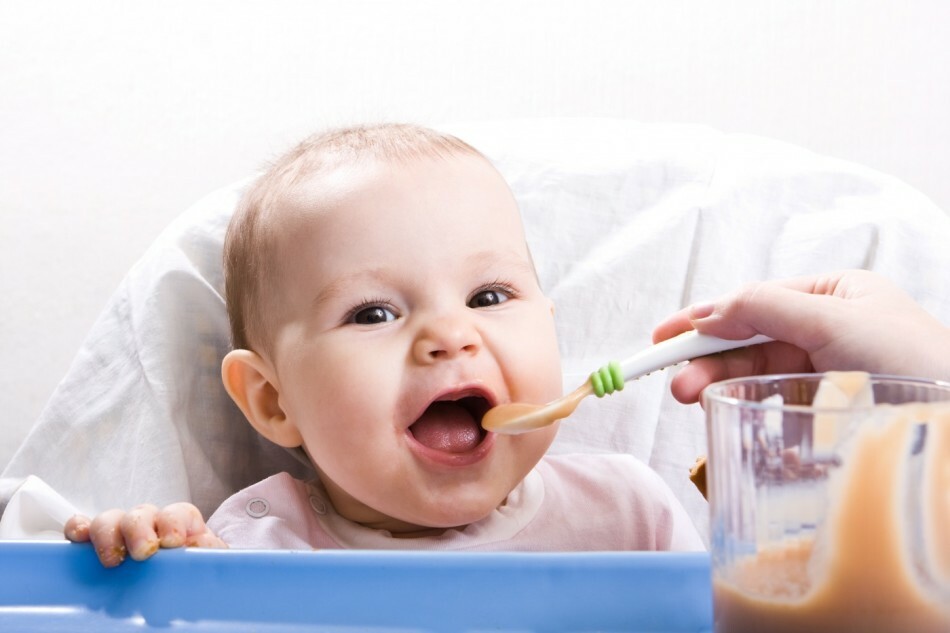Content of
- The correct feeding of a child by months to a year
- Video: "Feeding a baby. Where to begin? How to feed? When? "
- Detailed lure by months with breastfeeding: table
- Video:" Does breastfeeding need to be complemented with lure? "
- Safe lure by months with artificial feeding: table
- Video:" Artificial feeding "
- Baby diet for each month, usefuladvice and recommendations
- Video: "When and where to start feeding?"
- Addictive menu for babies breastfeeding and artificial feeding
- Video: "Lure. Feeding a child by month »
The correct feeding of a child by months to a year
- In the life of every baby comes the moment when milk for a full-fledged diet is already becoming scarce. The child with every month is more active, it grows and requires more calories and nutrients.
- . Feeding is the introduction of new foods into the baby's diet. It should be done correctly, taking into account all the features of the age, health and needs of the
- . As practice shows, small children like to try "adult food".It differs significantly from breast milk, has many flavors and a different texture.
- . Parents need to build a correct lure, observing the size and composition of portions for their child so as not to cause frustration, poisoning or constipation. It is important not to offer everything to the child, but to understand and clearly formulate the scheme of the products that need to be introduced first and which ones do not have
 feeding the baby with a spoon, the first foods of complementary food
feeding the baby with a spoon, the first foods of complementary food Important: The nutritional value of complementary foods perfectly complements breast milk or artificial milk formula.
It's not a secret that the nutrition of a child is the basis of his health for the rest of his life. This is a kind of "foundation" for the baby. That is why the lure should be phased, smooth and varied.
There are certain rules for the introduction of various foods that should not be ignored. They are listed in special tables of monthly additions and this schedule should be adhered to by each responsible mother.
Lure can be of vegetable origin:
- fruit puree
- vegetable puree
- juices, compotes, kissels
- cereals, soups
Also there is a complementary feeding and animal origin:
- eggs
- curd
- kefir
- milk porridges
- meat
- fish
Lure helps wean the kidfrom breast milk and mixtures. The fact is that such food stimulates the secretion of digestive enzymes, develops chewing skills and interests the child with its taste qualities. Each mother should closely monitor the needs and development of her child to accurately understand that he needs a lure. This can be said by such factors as:
- deviation of the child's weight to low rates indicates that the baby is often hungry and loses weight
- the emergence of a strong interest in what the mother eats says that the baby is bored watching and he also wantstry this food
- capricious behavior of the baby after feeding with milk indicates that he remains hungry and this food is not enough for him to eat well
 porridge - one of the first lures for the baby
porridge - one of the first lures for the baby These factors can appear at any age, but more oftenthey begin to manifest themselves after four months. However, pediatricians and experienced specialists strongly recommend the introduction of complementary foods when the child reaches the age of six.
This recommendation is relevant for those women who have sufficient breast milk. In other cases, when a child is on artificial feeding, he may require complementary feeding a little earlier than six months.
It is impossible to hurry to feed a baby with "adult food" because it is not always able to have a beneficial effect. This happens because the child's digestive system is not ready for heavy and unusual food. This is why it is possible to observe such phenomena as liquid and frequent stools, vomiting and regurgitation, fever, colic in the intestines and abundant gas formation.
Video: "Feeding the baby. Where to begin? How to feed? When? »
Detailed lure by months with breastfeeding: table
The correct start of feeding will ensure your baby a smooth introduction to adult food and will create a minimum of health problems. Doctors recommend starting the introduction of complementary foods with the help of a spoon. It is the spoon that breaks the child from the breast or nipples, that is, it forms the skills of proper eating behavior.
It is also useful for every mother to keep a food diary. This detail will allow you to carefully monitor what kind of food the baby uses and how it reacts.
 spoon for feeding an infant
spoon for feeding an infant By introducing other foods into the diet of an infant, you should know all the features of its digestive system, the baby's propensity for constipation or diarrhea. All because different food causes different reactions. For example, rice porridge strengthens, and fiber from fruits and vegetables is weakened.
It is important to know that after starting the lure, the child's chair will form and normalize only after a week, before that time one can observe the mucus impurities in the feces that arise as a result of the enzyme production.
The Association of World Children's Doctors concluded that the first lure should include special cereals and dairy products. Concentrated juice is harmful for children under the age of nine months. All because it contains a huge amount of acids, which can adversely affect the infant's digestive system. The juices that you give to your child must be diluted twice and thrice with purified water.
Tentative scheme for feeding complementary feeding to breastfed babies:
 Breast milk remains the main food for babies. Breast should be given to the child immediately after you have tried to feed it with other food. Be careful and the first porridges for the baby cook only on the water, without any trace of milk. Give preference to white, light and greenish vegetable and fruit puree at the first lure, they are easy for digestion.
Breast milk remains the main food for babies. Breast should be given to the child immediately after you have tried to feed it with other food. Be careful and the first porridges for the baby cook only on the water, without any trace of milk. Give preference to white, light and greenish vegetable and fruit puree at the first lure, they are easy for digestion.
Important: Only two months later you can start making original mixes and multi-component puree mixtures. Remember that the purpose of complementary feeding in the first months of a child's life is not to satisfy him with foreign food, but to teach his digestive system to work with other foods.
Video: "Should breastfeeding be supplemented with lure?"
Safe lure by months with artificial feeding: table
As mentioned earlier, children who are on artificial feeding may require complementary feeding much earlier than those that are breastfeeding. The reason for this is the fact that breast milk contains eight times more useful micronutrients than the best milk formula. If you notice for your child the need for lure, begin his correct introduction.
First of all, make sure that at the moment your baby is absolutely healthy and has no digestive disorders that can occur for various reasons: the teeth are chopped, for example, or a cold.
Do not try to give your child at a time the maximum number of foods and limit the feeding to a maximum of one new item every day. The first lure should be liquid enough for the baby to cope with it. Choose not concentrated juices or dilute puree with purified water.
Try to combine nutrition with bottled milk. Offer him a spoonful of food and then milk. During the day, do not forget to offer the child water to drink, so that it does not have constipation( artificial milk is saturated with protein).
 indicative table of introduction of complementary feeding with artificial feeding
indicative table of introduction of complementary feeding with artificial feeding It is necessary to check the reaction of the baby to the product and only then to try to introduce a new one. Try to start the lure not with the vegetable, but with the fruit mixture. This will allow the baby to enjoy the sweet food and try to open his mouth for a spoon.
Video: "Artificial feeding"
Baby's diet for each month, useful advice and recommendations
Each month your child will grow and his needs for more caloric and tasty food will grow. In lure it is important to observe the necessary consistency for food: start feeding with liquid, continue to puree and then introduce a piece. This mode allows you to properly develop chewing skills and accustom your stomach to digesting food.
Many products may have an allergic reaction: fruits, some vegetables or cereals. Therefore, carefully monitor your child's behavior: how he feels and what his chair is. When observing any negative reaction, limit the consumption of this product for a while.
 feeding the baby puree
feeding the baby puree The older the baby becomes, the more often you need to feed him during the day. So, the first lure mono to exercise once a day and increase over time to three meals. Remember that the first feedings should not be abundant and you need to start with just a few drops of the product.
 food input for the baby by months
food input for the baby by months Gradual and moderate introduction to the diet of food will allow the child to form the right habits and adjust the digestive system. When starting a lure, be sure to adhere to the table and do not forget to follow the sensations of the baby, as well as his wishes. Little babies are also people, and they, like adults, are able to favor certain foods and deny others.
Do not force the child to eat with a spoon, if he is not ready for it yet. In any case, interest in "adult food" he must appear, but only when there is a need.
Video: "When and where to start feeding?"
Addictive menu for babies breastfeeding and artificial feeding
Each mother decides for herself which foods will be the first lure of the baby: those that are sold in the store or those that can be cookedyourself. The main and basic rule to be followed is the complete sterility of children's dishes and the naturalness of the ingredients.
Do not try to teach your child to eat several foodstuffs at once, do not force him and give his tiny digestive system the ability to cope with minimal amounts of food. Starting the lure, dilute even the most liquid gruel, mashed potatoes and juices with water to avoid poisoning and allergic reactions.
 lure, child-centered
lure, child-centered Remember that your baby's diet should not include harmful foods. Even at the end of twelve months, chocolate sweets, cakes, mayonnaise, sausage, fast food and other food products are not allowed. If you want to please him sweet, then the sweetest for him should be natural jam or jam.
Remember, a lure is really necessary for a child if he owns certain "adult skills."Such as:
 Is the child ready for lure?
Is the child ready for lure? A sample feeding menu for a six-month-old baby:
- First week: breastmilk( or mixture) and a teaspoon of baby porridge( oatmeal or buckwheat), a few drops of juice or diluted puree
- every other day. Second week: breastMilk( or mixture) and three teaspoons of baby cereal, vegetable puree white or green( less allergenic) - teaspoon
- Third week: increase the number of cereals and fruit and vegetable mixes throughout the day, every meal of "drink" milk
